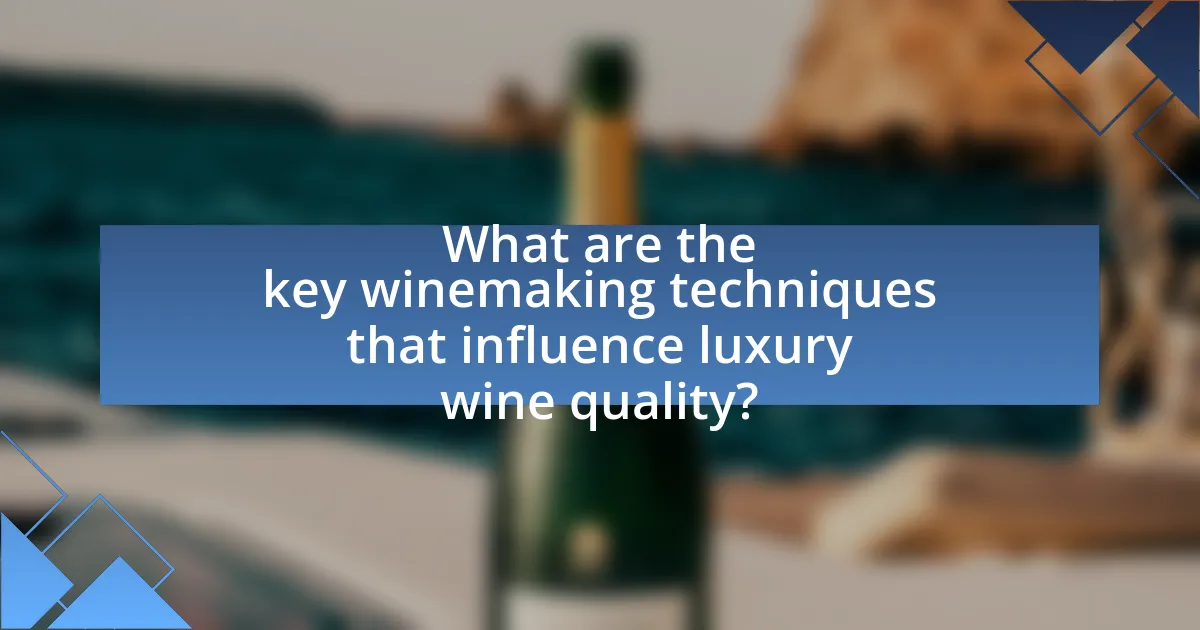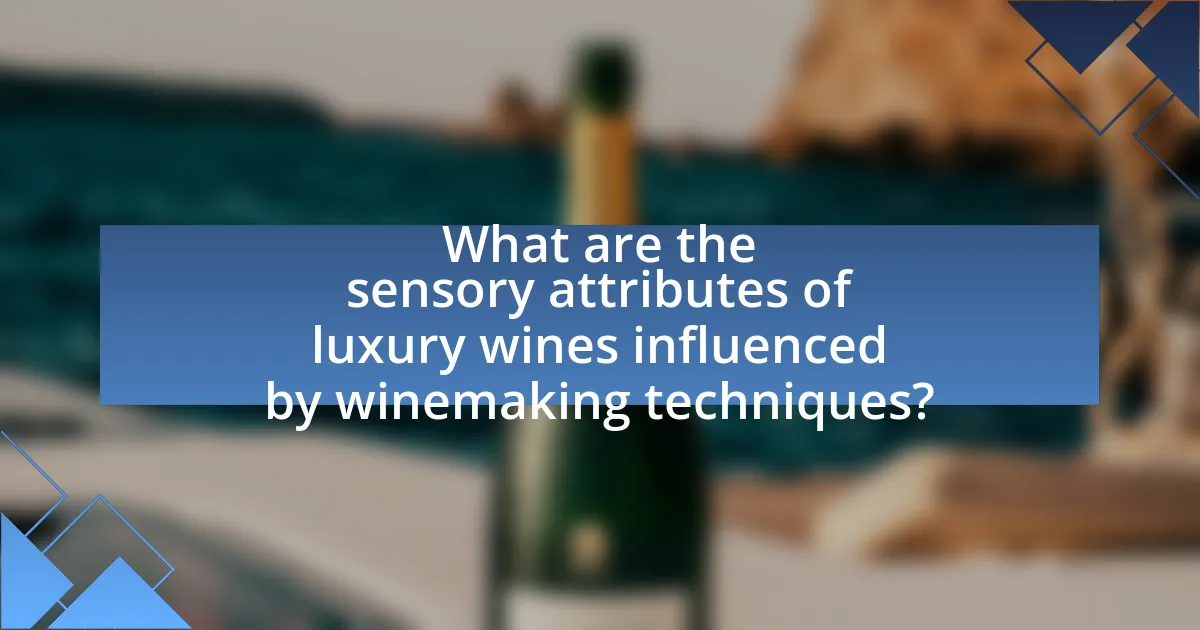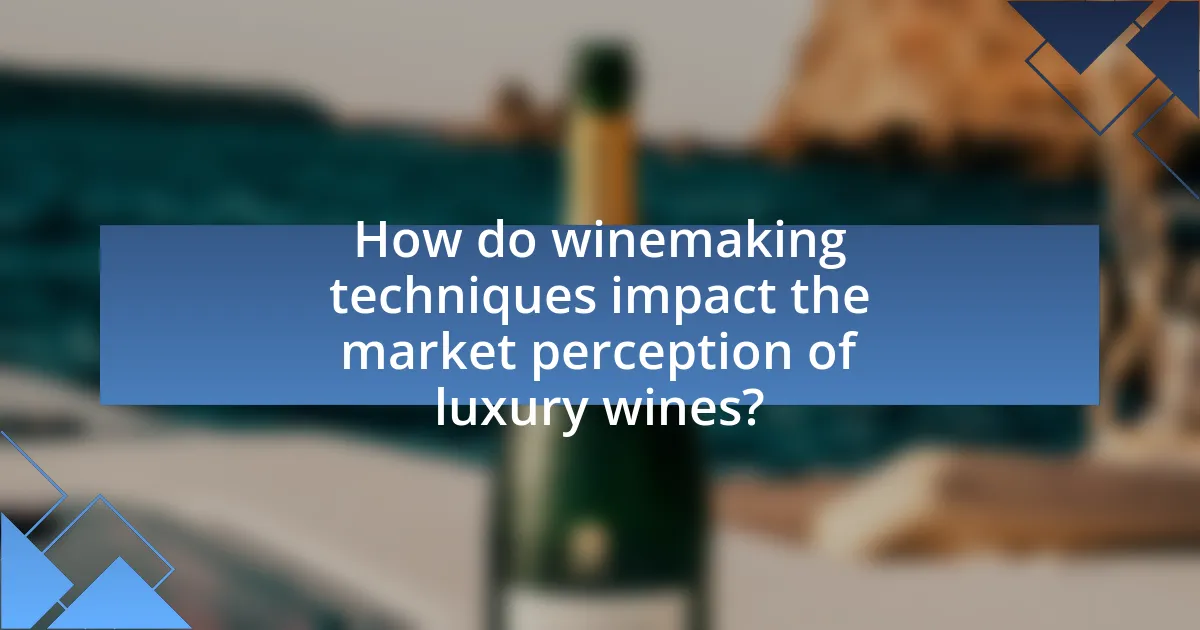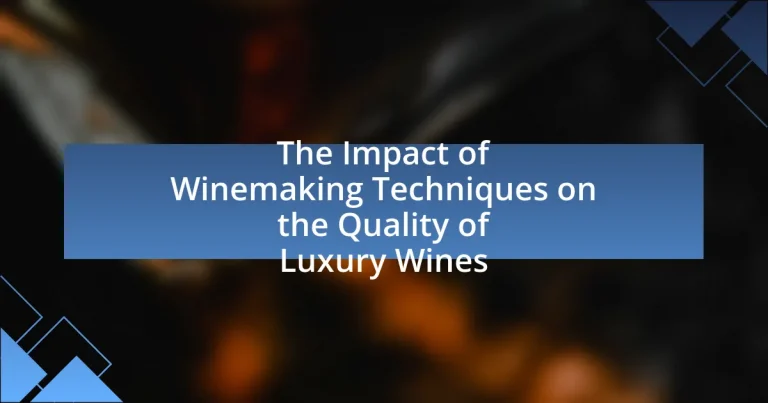The article examines the impact of winemaking techniques on the quality of luxury wines, highlighting key practices such as meticulous grape selection, precise fermentation control, and careful aging processes. It discusses how fermentation methods and temperature control influence flavor profiles, while the choice of yeast and aging techniques contribute to the wine’s complexity and sensory attributes. Additionally, the article explores the significance of vineyard management and terroir in enhancing grape quality, as well as the relationship between winemaking methods and market perception. Overall, it emphasizes that the application of specific techniques directly correlates with the perceived quality and desirability of luxury wines.

What are the key winemaking techniques that influence luxury wine quality?
Key winemaking techniques that influence luxury wine quality include meticulous grape selection, precise fermentation control, and careful aging processes. Meticulous grape selection ensures only the highest quality fruit is used, often sourced from specific vineyard sites known for their terroir, which significantly impacts flavor and complexity. Precise fermentation control, including temperature management and yeast selection, allows winemakers to enhance desired characteristics and maintain balance in the wine. Finally, careful aging processes, whether in oak barrels or stainless steel, contribute to the development of nuanced flavors and aromas, with oak aging imparting additional complexity through tannin integration and micro-oxygenation. These techniques are supported by studies indicating that the quality of grapes and the methods employed during fermentation and aging directly correlate with the perceived quality of luxury wines.
How do fermentation methods affect the flavor profile of luxury wines?
Fermentation methods significantly influence the flavor profile of luxury wines by altering the chemical composition and sensory characteristics of the final product. Different fermentation techniques, such as spontaneous fermentation, controlled fermentation, and the use of various yeast strains, can enhance or modify flavors, aromas, and textures in the wine. For instance, spontaneous fermentation often leads to more complex and nuanced flavors due to the diverse range of wild yeasts involved, while controlled fermentation allows winemakers to achieve specific flavor profiles by selecting particular yeast strains known for enhancing fruity or floral notes. Studies have shown that the choice of fermentation temperature also plays a crucial role; higher temperatures can extract more phenolic compounds, contributing to richer flavors and mouthfeel. Thus, the fermentation method directly impacts the overall quality and distinctiveness of luxury wines, making it a critical aspect of winemaking.
What role does temperature control play in fermentation quality?
Temperature control is crucial for fermentation quality as it directly influences yeast activity and metabolic processes. Maintaining optimal temperatures ensures that yeast ferments sugars efficiently, producing desirable flavors and aromas while minimizing the production of unwanted byproducts such as volatile acidity and off-flavors. Research indicates that fermentation temperatures typically range from 18°C to 24°C for white wines and 25°C to 30°C for red wines, with deviations potentially leading to stuck fermentations or spoilage. For instance, a study published in the Journal of Agricultural and Food Chemistry found that precise temperature management during fermentation significantly improved the aromatic profile of wines, demonstrating the importance of temperature control in achieving high-quality luxury wines.
How does the choice of yeast impact the final product?
The choice of yeast significantly impacts the final product in winemaking by influencing fermentation characteristics, flavor profiles, and overall wine quality. Different yeast strains can produce varying levels of alcohol, acidity, and aromatic compounds, which directly affect the taste and aroma of the wine. For example, Saccharomyces cerevisiae is commonly used for its reliable fermentation and ability to enhance fruity flavors, while non-Saccharomyces yeasts can contribute complexity and unique aromas. Studies have shown that the specific yeast strain selected can lead to differences in volatile compounds, such as esters and phenols, which are crucial for the sensory attributes of luxury wines. Thus, the yeast choice is a critical factor in determining the final quality and style of the wine produced.
What is the significance of aging techniques in luxury winemaking?
Aging techniques in luxury winemaking are significant because they enhance the complexity, flavor, and overall quality of the wine. These techniques, which include barrel aging, bottle aging, and controlled oxidation, allow the wine to develop nuanced aromas and flavors over time. For instance, barrel aging can impart tannins and vanillin from the wood, contributing to a wine’s structure and mouthfeel. Studies have shown that wines aged in oak barrels can exhibit a greater depth of flavor compared to those that are not, with some luxury wines benefiting from aging periods of several years to decades. This maturation process is crucial for achieving the desired balance and harmony in high-quality wines, making aging techniques a fundamental aspect of luxury winemaking.
How do different types of barrels influence wine characteristics?
Different types of barrels significantly influence wine characteristics through variations in wood type, toasting levels, and barrel age. For instance, oak barrels impart flavors such as vanilla, spice, and toast due to the wood’s natural compounds, while the level of toasting can enhance or mellow these flavors. French oak typically provides more subtle and complex flavors compared to American oak, which tends to be bolder and more pronounced. Additionally, the age of the barrel affects the extraction of these flavors; newer barrels contribute more intense characteristics, while older barrels offer more subtle nuances. Studies have shown that the choice of barrel can alter the wine’s aroma, taste, and mouthfeel, ultimately impacting the overall quality and profile of luxury wines.
What is the impact of aging duration on luxury wine quality?
Aging duration significantly enhances luxury wine quality by allowing complex flavors and aromas to develop. As wine ages, chemical reactions occur that soften tannins, integrate flavors, and enhance aromatic profiles, resulting in a more balanced and refined product. Research indicates that optimal aging periods vary by wine type; for instance, red wines often benefit from aging between 5 to 15 years, while certain white wines may reach their peak within 3 to 7 years. Studies, such as those published in the Journal of Wine Research, demonstrate that wines aged beyond their optimal window can lose freshness and vibrancy, underscoring the importance of precise aging duration in achieving luxury wine quality.
How does vineyard management contribute to the quality of luxury wines?
Vineyard management significantly contributes to the quality of luxury wines by optimizing grape growing conditions and ensuring meticulous care throughout the cultivation process. Effective vineyard management practices, such as soil analysis, precise irrigation, and canopy management, directly influence grape health and ripeness, which are critical for producing high-quality wines. For instance, studies have shown that managing vine density and leaf area can enhance sunlight exposure and air circulation, leading to better fruit development and flavor concentration. Additionally, practices like selective harvesting ensure that only the best grapes are used, further elevating the wine’s quality.
What practices in viticulture enhance grape quality for luxury wines?
Practices in viticulture that enhance grape quality for luxury wines include meticulous canopy management, precise irrigation techniques, and selective harvesting. Canopy management, which involves optimizing sunlight exposure and air circulation, promotes even ripening and reduces disease pressure, leading to healthier grapes. Precise irrigation techniques, such as deficit irrigation, help control vine stress and concentrate flavors, resulting in more complex wines. Selective harvesting ensures that only the best grapes, at optimal ripeness, are chosen, which directly impacts the quality of the final product. These practices are supported by research indicating that vineyard management significantly influences grape composition and, consequently, wine quality.
How does terroir affect the overall quality of luxury wines?
Terroir significantly influences the overall quality of luxury wines by encompassing the unique combination of soil, climate, topography, and local viticultural practices. This interaction determines the grape variety’s expression, affecting flavor, aroma, and complexity. For instance, the mineral content in the soil can impart distinct characteristics to the wine, while climate conditions, such as temperature and rainfall, directly impact grape ripening and acidity levels. Studies have shown that wines from regions with well-defined terroirs, like Bordeaux or Burgundy, often achieve higher ratings and prices due to their unique qualities, which are a direct result of their specific terroir.

What are the sensory attributes of luxury wines influenced by winemaking techniques?
The sensory attributes of luxury wines influenced by winemaking techniques include aroma, flavor, texture, and finish. These attributes are shaped by various techniques such as fermentation methods, aging processes, and the use of oak barrels. For instance, the choice of fermentation temperature can enhance fruity or floral aromas, while malolactic fermentation can soften acidity and add creaminess to the texture. Aging in oak barrels imparts flavors like vanilla, spice, and toast, contributing to the complexity of the wine. Studies have shown that these techniques can significantly elevate the perceived quality and enjoyment of luxury wines, as evidenced by consumer preference surveys indicating higher ratings for wines that utilize advanced winemaking practices.
How do winemaking techniques shape the aroma and bouquet of luxury wines?
Winemaking techniques significantly shape the aroma and bouquet of luxury wines through processes such as fermentation, aging, and blending. Fermentation methods, including the use of wild or cultured yeasts, influence the development of aromatic compounds, while temperature control during fermentation can enhance or suppress specific aromas. Aging in oak barrels introduces additional complexity, imparting flavors like vanilla, spice, and toast, which contribute to the overall bouquet. Furthermore, blending different grape varieties allows winemakers to create a harmonious balance of aromas, enhancing the wine’s complexity. Studies have shown that these techniques can lead to a more pronounced aromatic profile, with luxury wines often exhibiting a greater depth of flavor and aroma compared to standard wines.
What specific techniques enhance aromatic complexity in wines?
Specific techniques that enhance aromatic complexity in wines include fermentation with indigenous yeasts, extended maceration, and barrel aging. Fermentation with indigenous yeasts allows for a diverse range of aromatic compounds to develop, as these yeasts can produce unique esters and phenols that contribute to complexity. Extended maceration, which involves leaving grape skins in contact with the juice for longer periods, can extract additional flavor compounds and enhance aromatic profiles. Barrel aging, particularly in oak barrels, introduces compounds such as vanillin and lactones, which can add layers of aroma and flavor complexity. These techniques are supported by research indicating that the choice of yeast and fermentation conditions significantly influences the aromatic profile of the final wine.
How does the aging process contribute to the development of bouquet?
The aging process significantly contributes to the development of bouquet in wines by allowing complex chemical reactions to occur, which enhance aromatic compounds. During aging, phenolic compounds and esters evolve, leading to the formation of secondary and tertiary aromas that define a wine’s bouquet. For instance, the breakdown of tannins and the oxidation of certain compounds can produce notes of dried fruit, nuts, and spices, which are characteristic of aged wines. Research indicates that wines aged in oak barrels can develop additional layers of complexity due to the interaction with wood, which imparts flavors such as vanilla and toast. This transformation is essential for luxury wines, as it elevates their aromatic profile and overall quality.
What is the relationship between winemaking techniques and taste profiles?
Winemaking techniques directly influence taste profiles by affecting the chemical composition and sensory characteristics of the wine. For example, fermentation temperature can enhance or suppress certain flavor compounds; higher temperatures often lead to more robust fruit flavors, while cooler temperatures can preserve acidity and floral notes. Additionally, the choice of yeast strains can impart distinct aromas and flavors, such as fruity or spicy notes, which significantly shape the overall taste experience.
Furthermore, aging techniques, such as the use of oak barrels, contribute to flavor complexity by adding tannins, vanilla, and spice notes, which alter the wine’s mouthfeel and finish. Research indicates that wines aged in new oak barrels exhibit more pronounced flavors compared to those aged in neutral barrels, demonstrating a clear link between aging methods and taste profiles. Thus, the relationship between winemaking techniques and taste profiles is foundational to the quality and character of luxury wines.
How do tannins and acidity levels vary with different winemaking methods?
Tannins and acidity levels vary significantly with different winemaking methods, influencing the overall quality and character of luxury wines. For instance, traditional red winemaking techniques, which involve extended skin contact during fermentation, typically result in higher tannin extraction, leading to a more robust mouthfeel. In contrast, white winemaking methods, which often involve pressing grapes before fermentation, generally yield lower tannin levels and higher acidity, contributing to a crisper taste profile.
Additionally, the use of oak barrels in aging can enhance tannin complexity and introduce flavors that affect perceived acidity. Research indicates that wines aged in new oak barrels exhibit increased tannin levels due to the extraction from the wood, while also maintaining balanced acidity through malolactic fermentation, which softens harsh acids. Therefore, the choice of winemaking method directly impacts the balance of tannins and acidity, ultimately shaping the wine’s quality and luxury status.
What role does residual sugar play in the taste of luxury wines?
Residual sugar significantly influences the taste of luxury wines by enhancing sweetness, balancing acidity, and contributing to mouthfeel. In luxury wines, a carefully measured amount of residual sugar can create a harmonious profile that elevates the overall tasting experience. For instance, in dessert wines like Sauternes, the presence of residual sugar is essential for achieving the rich, luscious flavors that define the style. Additionally, wines with residual sugar often exhibit a longer finish, as the sweetness lingers on the palate, providing a more complex tasting experience. This balance between sweetness and acidity is crucial, as it prevents the wine from tasting cloying and instead allows for a more refined and elegant flavor profile.

How do winemaking techniques impact the market perception of luxury wines?
Winemaking techniques significantly influence the market perception of luxury wines by enhancing quality attributes that consumers associate with premium products. Techniques such as meticulous vineyard management, selective harvesting, and precise fermentation processes contribute to the complexity, flavor, and overall quality of the wine, which in turn elevates its status in the eyes of consumers. For instance, the use of oak aging can impart unique flavors and aromas, making the wine more desirable and often leading to higher price points. Additionally, limited production methods, such as small-batch winemaking, create a sense of exclusivity, further enhancing the perceived value. Research indicates that consumers are willing to pay a premium for wines that demonstrate superior craftsmanship and authenticity, as evidenced by a study published in the Journal of Wine Economics, which found that perceived quality directly correlates with the winemaking techniques employed.
What marketing strategies highlight the influence of winemaking techniques?
Marketing strategies that highlight the influence of winemaking techniques include storytelling, educational content, and sensory experiences. Storytelling emphasizes the unique processes and traditions behind each wine, creating a narrative that connects consumers to the winemaking techniques. Educational content, such as workshops and tastings, informs consumers about the specific methods used, enhancing their appreciation and understanding of the wine’s quality. Sensory experiences, like guided tastings that focus on the impact of techniques on flavor profiles, allow consumers to directly engage with the product, reinforcing the connection between winemaking methods and the resulting wine quality. These strategies effectively communicate the craftsmanship involved in luxury wines, thereby influencing consumer perceptions and purchasing decisions.
How do producers communicate the quality derived from specific techniques?
Producers communicate the quality derived from specific winemaking techniques through detailed labeling, marketing narratives, and sensory descriptions. For instance, they often highlight techniques such as barrel aging, fermentation methods, and vineyard practices on wine labels, which informs consumers about the craftsmanship involved. Research indicates that wines aged in oak barrels often exhibit enhanced complexity and flavor profiles, which producers emphasize to convey quality. Additionally, producers may use tasting notes that describe the wine’s aroma, taste, and mouthfeel, linking these characteristics directly to the techniques employed, thereby reinforcing the perceived quality of the wine.
What role does storytelling play in the luxury wine market?
Storytelling plays a crucial role in the luxury wine market by enhancing brand identity and consumer connection. Luxury wine brands often use narratives about their heritage, winemaking processes, and unique terroirs to create an emotional bond with consumers, which can justify premium pricing. For instance, brands like Château Margaux emphasize their historical significance and traditional methods, which not only elevate their status but also resonate with consumers seeking authenticity and exclusivity. This narrative-driven approach has been shown to increase perceived value, as consumers are willing to pay more for wines that come with compelling stories, thus reinforcing the importance of storytelling in driving sales and brand loyalty in the luxury wine sector.
What are the best practices for aspiring winemakers to enhance luxury wine quality?
Aspiring winemakers can enhance luxury wine quality by focusing on meticulous vineyard management, precise fermentation techniques, and careful aging processes. Effective vineyard management includes selecting optimal grape varieties for the terroir, implementing sustainable farming practices, and ensuring proper canopy management to maximize sunlight exposure and air circulation. Precise fermentation techniques involve controlling temperature and utilizing native yeasts to enhance the wine’s complexity and character. Additionally, careful aging processes, such as using high-quality oak barrels and monitoring the aging environment, contribute to the development of desirable flavors and aromas. These practices are supported by research indicating that vineyard health and winemaking precision significantly influence the sensory attributes of luxury wines, ultimately leading to higher quality products.
How can new winemakers effectively implement traditional techniques?
New winemakers can effectively implement traditional techniques by studying historical practices and adapting them to modern contexts. For instance, techniques such as hand harvesting, natural fermentation, and aging in oak barrels have been proven to enhance the complexity and quality of wines, as evidenced by the success of renowned regions like Bordeaux and Burgundy, where these methods have been utilized for centuries. By incorporating these time-tested methods, new winemakers can create wines that reflect both tradition and innovation, ultimately improving the overall quality of their products.
What common pitfalls should be avoided in luxury winemaking?
Common pitfalls to avoid in luxury winemaking include neglecting terroir, over-manipulation of the wine, and inadequate aging processes. Neglecting terroir can lead to wines that lack the unique characteristics derived from their specific growing environment, which is essential for luxury wines. Over-manipulation, such as excessive use of additives or technological interventions, can compromise the wine’s authenticity and complexity, detracting from its luxury status. Inadequate aging processes can result in wines that are either too young or improperly developed, failing to reach their full potential in flavor and structure. These pitfalls can significantly diminish the quality and reputation of luxury wines, as evidenced by the emphasis on terroir and traditional methods in renowned wine regions like Bordeaux and Burgundy, where the best wines are often those that reflect their origins without excessive intervention.


